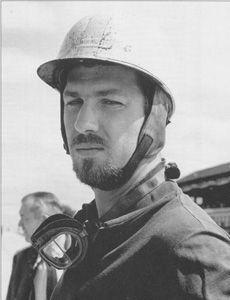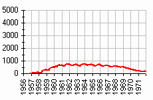Гонщики, B | |
Bonnier, Jo Курсивом отмечены гонщики, |
| Йо БоньерBonnier, JoBonnier, Joakim |
 (c) 'Who is Who' by Steve Small, 2000 Родился: 30.01.1930 Дьюргарден, Стокгольм Умер: 11.06.1972 трасса Ле-Ман, Франция Сезонов в Ф1: Лет в Ф1: 16 Гран При: Старты: 104* *не стартовал: 17 Победы: - подряд: Подиумы: - подряд: Поул-позиции: - подряд: Первый ряд: - подряд: 2 Быстрые круги: - подряд: Лучший финиш: Лучший старт: 1 Дубли: Хет-трики: Лидирование старт/финиш: Большие шлемы: Круги: - лидирования: 139 Километры: - лидирования: |
Год | Команда | Шасси |
From a comfortable background, this Swedish driver had built a mighty reputation as an ice-racer in the early fifties with an Alfa Romeo Disco Volante, which led to him being appointed a distributor for that marque in 1954. Moving into circuit racing the following year, Bonnier soon proved to be a front-runner in Scandinavia before venturing further afield in 1956 to race the GT Alfa, winning events at Aintree, AVUS and Castelfusano, and taking a class win at the Nürburgring 1000 Km with Mackay-Fraser. By now he had started to run Maserati sports cars, and in 1957 became involved with the works team, finishing third in the Swedish GP in a SOOTS.
Although he had not really reached the front rank of drivers, Jo bought a Maserati 250F which he raced in the 1957-58 seasons with only moderate results, the best being second places at Syracuse and Caen against meagre opposition. At the tail-end of 1958 he joined BRM and soon became the first driver to win a championship Grand Prix for Bourne when he won the 1959 Dutch GP. He was to stay with BRM until the end of the 1960 season, but never came close to repeating his Zandvoort triumph, although he comfortably led the 1960 Argentine GP until the engine failed.
Having begun a successful association with Porsche in 1959, Bonnier took every opportunity to race for them again the following year, winning the Modena GP and taking a superb victory in the rain in the non-championship German GP in F2, and sharing the victorious RSK sports car with Herrmann in the Targa Florio. With the Porsche team planning a Grand Prix assault in 1961, Bonnier - feeling his talents were being overlooked at BRM -joined Dan Gurney to race the silver cars. After a winter interlude which included taking a Yeoman Credit Cooper to victory in New Zealand at the Teretonga international and at Levin, the 1961 season started with a second place in Seidel's Lotus at Pau before Bonnier concentrated on his Porsche commitments. He made a promising beginning, with some good results in non-championship races, including second places at Solitude, Karlskoga and Modena and thirds at Syracuse and Zeltweg, but in Grands Prix things were much tougher, and he was increasingly overshadowed by Gurney, especially in 1962 when he endured a fairly depressing time with the new Porsche 804 flat-eight, with a second place at Solitude and a third at the Karlskoga GP his only worthwhile results.
With Porsche withdrawing from Formula 1, Bonnier joined Rob Walker in 1963 and raced his privately entered cars for the next three seasons. When the mood took him he could still be extremely quick, but by now he seemed more interested in his pivotal role as leader of the newly formed Grand Prix Drivers' Association. When Walker released him for 1966, Jo formed his own team, picking up occasional points racing a Cooper-Maserati and then a McLaren, as well as scrounging a few works drives, but he was really a shadow of his former self, especially in 1971, when he was very slow indeed.
If nothing else Bonnier still enjoyed the life of a racing driver, and while the best days of his Grand Prix career had long been in the past, he raced sports cars with great gusto. He shared a Chaparral with Phil Hill to win the Nürburgring 1000 Km in 1966 and raced his own and the Ecurie Filipinetti's Lola T70s with some minor success, but it was the acquisition of a 2-litre Lola in 1970 that seemingly reawakened the racer that had for so long lain dormant. He won G5/6 races at both Silverstone and Jyllandsring and took the European 2-litre championship with some terrific drives.
Although just past 40, Bonnier's racing activities showed no sign of slackening in 1971, and his lacklustre Grand Prix performances were thrown into sharp relief by some more good results in the sports car categories, including a third in the Targa Florio with Attwood, second place in the Auvergne Trophy and an outright win in the Barcelona 1000 Km with Peterson. Retiring from Formula 1 at the end of the season, Bonnier raced on in a new Lola T280. However, at Le Mans in 1972 he was involved in a collision with a privateer Ferrari, and Jo's yellow Lola was launched over the barriers into the trees. The man who had spent so much time crusading for circuit safety over the years had become another victim among a whole generation of racers who paid the ultimate price.
(c) 'Who is Who' by Steve Small, 2000
| © WildSoft, 1995-2020 |


